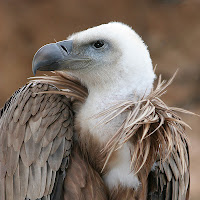Vulture Culture
 The Alcornocales Natural Park is home to at least 800 pairs of griffon vultures, and these magnificent if somewhat scary-looking birds can often be seen circling slowly on the thermals in the skies over Alcalá. They like to nest among inaccessible crags, and there is a nesting site within walking distance of the town, past the campsite along the sendero de los molinos.
The Alcornocales Natural Park is home to at least 800 pairs of griffon vultures, and these magnificent if somewhat scary-looking birds can often be seen circling slowly on the thermals in the skies over Alcalá. They like to nest among inaccessible crags, and there is a nesting site within walking distance of the town, past the campsite along the sendero de los molinos.
The griffon vulture (Gyps fulvus) or buitre leonado as it is known in Spanish, is enormous. It grows up to110 cm (43") long with a wingspan of around 2.5 metres - just over 8 ft. First-time visitors often mistake them for eagles, but as a general rule eagles fly solo and vultures fly in groups. They are also a completely different shape, with a bald head (more hygienic for burrowing deep in the entrails of a cow), very broad wings with "fingers" on the end, and short tail feathers. It has a white neck ruff and yellow bill.
 |
| VULTURE NEST SITE NEAR ALCALÁ |
They feed on carrion, and in the past farmers would leave carcasses of dead livestock out on the mountains for them; a clean and effective way of disposing of the bodies. However in 2002 an EU regulation was passed which made this practice illegal; the idea was to control the spread of BSE ("mad cow disease") but it also led to hungry vultures plundering urban rubbish tips like the one at Los Barrios. Special vulture feeding stations have been set up to help them - you can see one on the mountains above Tarifa (details here) - and the Spanish government is trying to get the law reversed. Numbers in the Alcornocales are said to be rising again.
Local writer Juan Leiva, in his series of childhood memories from the 1940s "Evocaciones Alcalainas", describes a moment of great excitement in the town when a some youths captured an injured griffon vulture and dragged it limping up and down the street followed by a large group of small boys:
Halfway down the Calle Real, near the house where Dr Antonio Armenta lived, the animal refused to get up again. The young man carried on thrashing it until finally the creature hung its head and died. Don Antonio stood in his doorway, making a gesture of disapproval at such a death. Later, with his authority as Doctor, he ordered it to be carried to the common land by the Playa, where we played football, and buried. That night, the vulture's sorrowful eyes would not let us sleep."

Comments